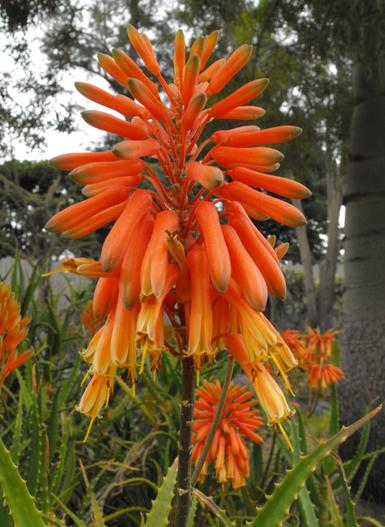Kenyan Aloe
(Aloe kedongensis)
Kenyan Aloe (Aloe kedongensis)
/
/

Stickpen
Public domain
Image By:
Stickpen
Recorded By:
Copyright:
Public domain
Copyright Notice:
Photo by: Stickpen | License Type: Public domain | License URL: https://creativecommons.org/public-domain/ | Uploader: Stickpen | Publisher: Wikipedia Commons













Estimated Native Range
Summary
Aloe kedongensis, commonly known as Kenyan Aloe, is a succulent perennial herb native to semi-arid regions of Kenya and northern Tanzania, where it thrives in rocky outcrops and on hillsides. It can form dense clumps with stems reaching up to 13 feet long, which bear slender, recurved leaves that are blue-green with a slight reddish tinge on the margins. The leaves are also armed with sharp, dark brown teeth along the edges, which can deter herbivores. The inflorescence, rising approximately 20 inches above the foliage, consists of a branched spike with tubular red flowers that are attractive to pollinators such as birds and bees. Flowering typically occurs in the dry season, and the flowers are quite showy, making it a striking feature in the landscape.
Kenyan Aloe is valued for its drought tolerance and architectural form, making it a popular choice for xeriscaping, rock gardens, and as a dramatic specimen plant in succulent collections. It is also used as a living fence or hedge in its native range, due to its size and the protective nature of its leaves. In cultivation, Aloe kedongensis requires well-drained soil, minimal water once established, and full sun to light shade. While generally low-maintenance, it can be susceptible to mealybugs and scale insects. Overwatering should be avoided to prevent root rot.CC BY-SA 4.0
Kenyan Aloe is valued for its drought tolerance and architectural form, making it a popular choice for xeriscaping, rock gardens, and as a dramatic specimen plant in succulent collections. It is also used as a living fence or hedge in its native range, due to its size and the protective nature of its leaves. In cultivation, Aloe kedongensis requires well-drained soil, minimal water once established, and full sun to light shade. While generally low-maintenance, it can be susceptible to mealybugs and scale insects. Overwatering should be avoided to prevent root rot.CC BY-SA 4.0
Plant Description
- Plant Type: Succulent
- Height: 6-8 feet
- Width: 4-5 feet
- Growth Rate: Moderate
- Flower Color: Orange, Red
- Flowering Season: Spring, Summer
- Leaf Retention: Evergreen
Growth Requirements
- Sun: Full Sun, Part Shade
- Water: Low, Medium
- Drainage: Fast, Medium
Common Uses
Border Plant, Drought Tolerant, Fire Resistant, Low Maintenance, Rock Garden, Showy Flowers
Natural Habitat
Semi-arid regions of Kenya and northern Tanzania, particularly on rocky outcrops and hillsides
Other Names
Common Names:
Scientific Names: , Aloe kedongensis, Aloe nyeriensis subsp. kedongensis,
GBIF Accepted Name: